ACURA NSX 1991 Service Repair Manual
Manufacturer: ACURA, Model Year: 1991, Model line: NSX, Model: ACURA NSX 1991Pages: 1640, PDF Size: 60.48 MB
Page 1191 of 1640

Description
Hydraulic Flow (cont'd)
The line pressure (1) becomes the line pressure (4), (18), (25) as it passes through the manual valve. Also, the line pressure (1) goes to the modulator valve through the filter and becomes the modulator pressure (6). The modulator pressure (6)
is supplied to the 1-2 shift valve and 2-3 shift valve. The 1 -2 shift and 2-3 shift valves are moved to the left side because the shift control solenoid valve A is turned ON and B
is OFF by the
TCM.
The line pressure (18) is supplied to the 3-4 shift valve, and it is moved to the left side. The line pressure (4) is the 1st
clutch pressure (10), then the 1st clutch is engaged.
The line pressure (4) becomes the 1st-hold clutch pressure (16) via the 1-2 shift valve, 2-3 shift valve, 3-4 shift valve
and manual valve, then the 1st-hold clutch is engaged.
NOTE:
When used,
"left"
or
"right" indicates
direction
on the
flowchart.
PositionProCarManuals.com
Page 1192 of 1640
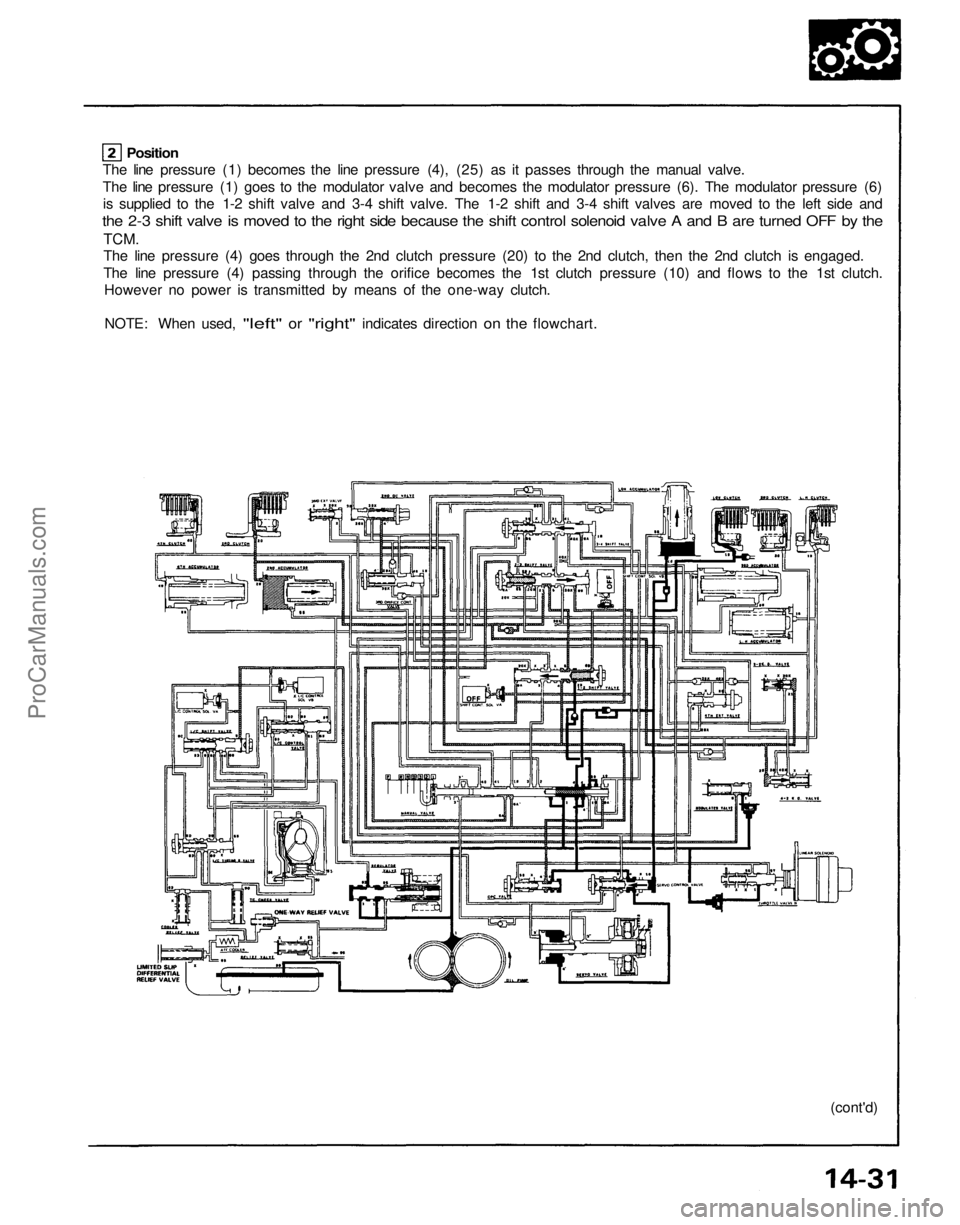
The line pressure (1) becomes the line pressure (4), (25) as it passes through the manual valve.
The line pressure (1) goes to the modulator valve and becomes the modulator pressure (6). The modulator pressure (6)
is supplied to the 1-2 shift valve and 3-4 shift valve. The 1-2 shift and 3-4 shift valves are moved to the left side and
the 2-3 shift valve is moved to the right side because the shift control solenoid valve A and B are turned OFF by the
TCM.
The line pressure (4) goes through the 2nd clutch pressure (20) to the 2nd clutch, then the 2nd clutch is engaged.
The line pressure (4) passing through the orifice becomes the 1st clutch pressure (10) and flows to the 1st clutch.
However no power is transmitted by means of the one-way clutch.
NOTE: When used,
"left"
or
"right"
indicates direction
on the
flowchart.
(cont'd)
PositionProCarManuals.com
Page 1193 of 1640
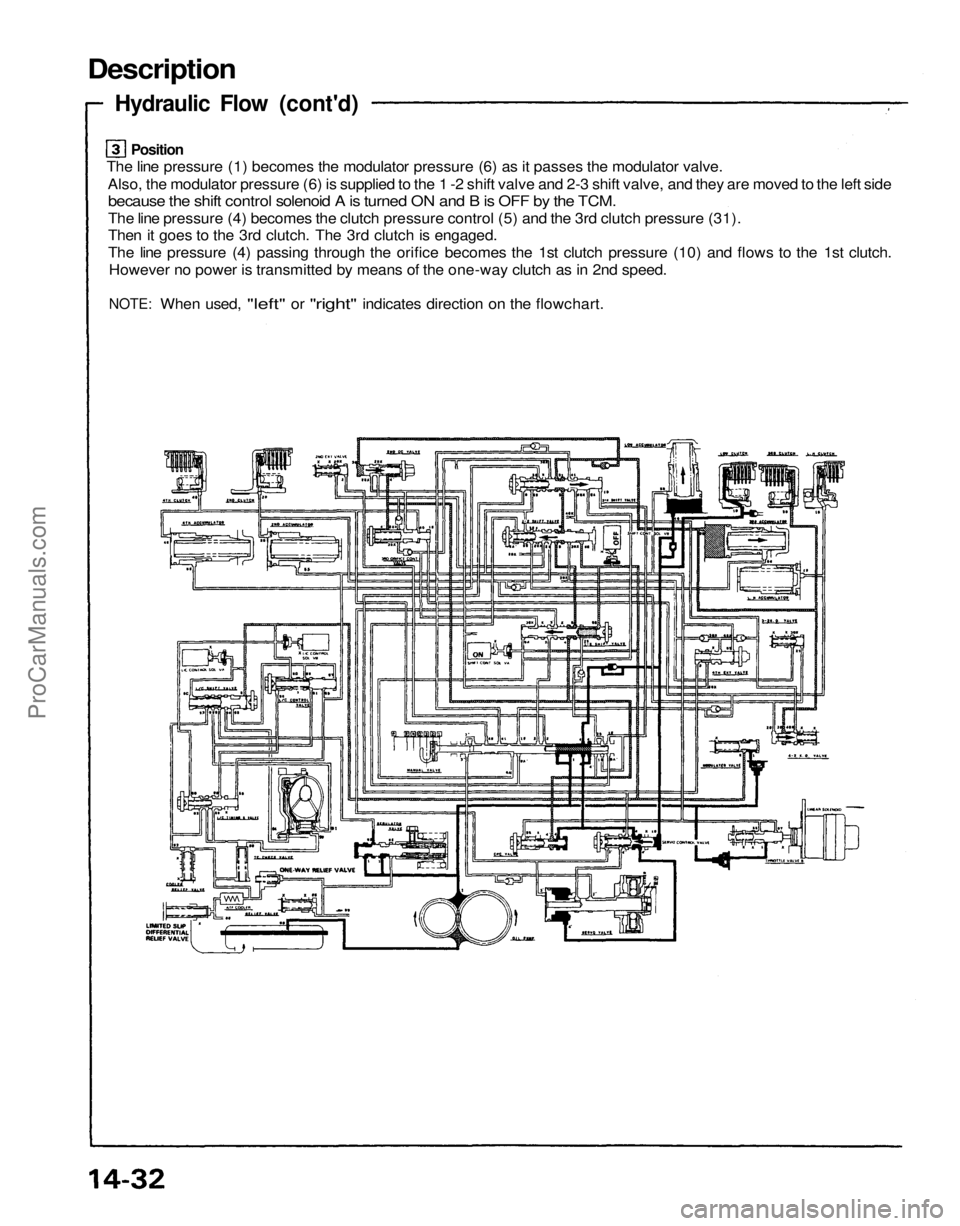
Description
Hydraulic Flow (cont'd)
The line pressure (1) becomes the modulator pressure (6) as it passes the modulator valve.
Also, the modulator pressure (6) is supplied to the 1 -2 shift valve and 2-3 shift valve, and they are moved to the left side
because the shift control solenoid A is turned ON and B is OFF by the TCM.
The line pressure (4) becomes the clutch pressure control (5) and the 3rd clutch pressure (31).
Then it goes to the 3rd clutch. The 3rd clutch is engaged.
The line pressure (4) passing through the orifice becomes the 1st clutch pressure (10) and flows to the 1st clutch.
However no power is transmitted by means of the one-way clutch as in 2nd speed.
NOTE:
When used,
"left"
or
"right"
indicates direction
on the
flowchart.
PositionProCarManuals.com
Page 1194 of 1640
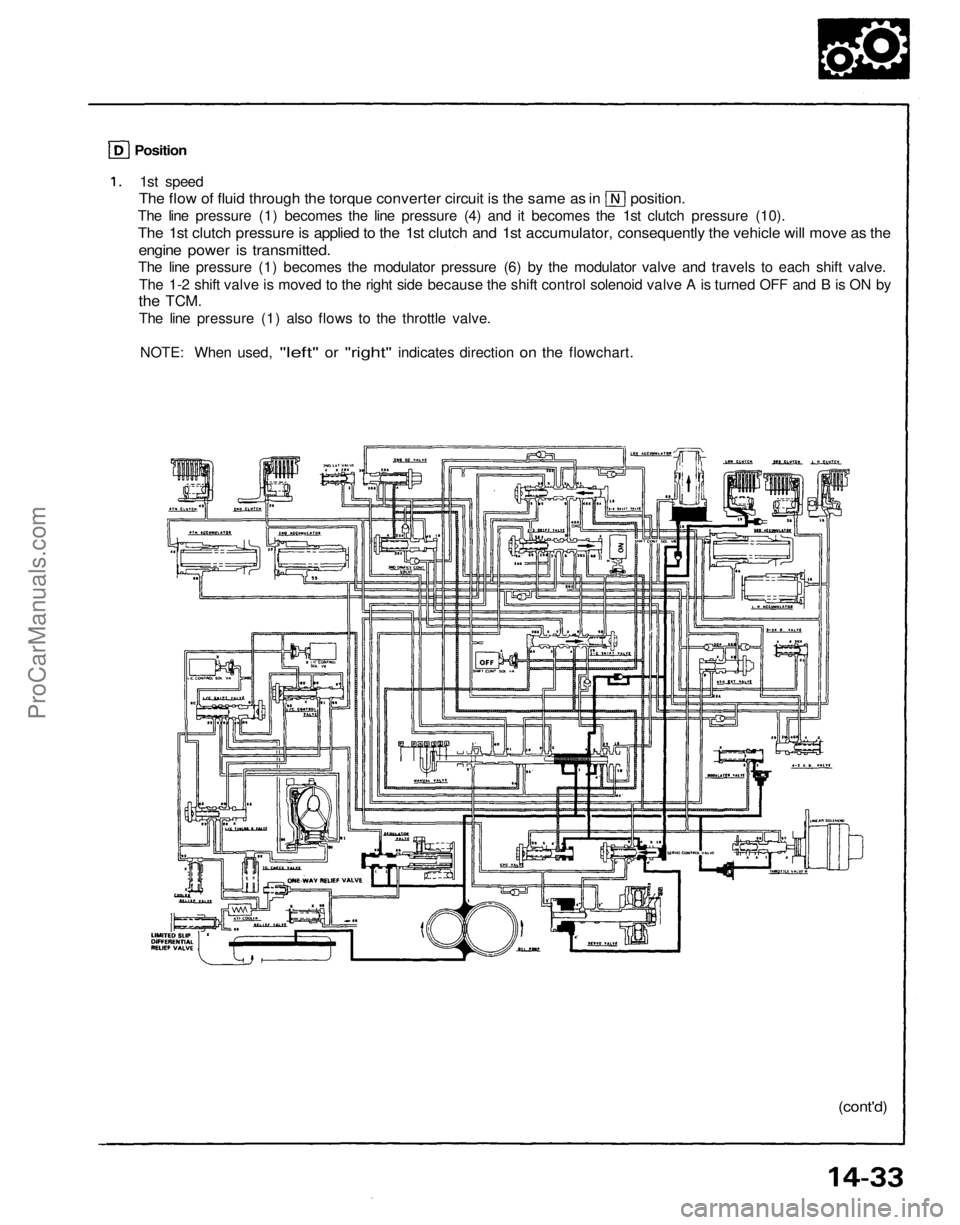
1st speed
The flow of fluid through the torque converter circuit is the same as in position.
The line pressure (1) becomes the line pressure (4) and it becomes the 1st clutch pressure (10).
The 1st clutch pressure is applied to the 1st clutch and 1st accumulator, consequently the vehicle will move as the
engine power is transmitted.
The line pressure (1) becomes the modulator pressure (6) by the modulator valve and travels to each shift valve.
The 1-2 shift valve is moved to the right side because the shift control solenoid valve A is turned OFF and B is ON by
the
TCM.
The line pressure (1) also flows to the throttle valve.
NOTE: When used,
"left"
or
"right"
indicates direction
on the
flowchart.
(cont'd)
PositionProCarManuals.com
Page 1195 of 1640
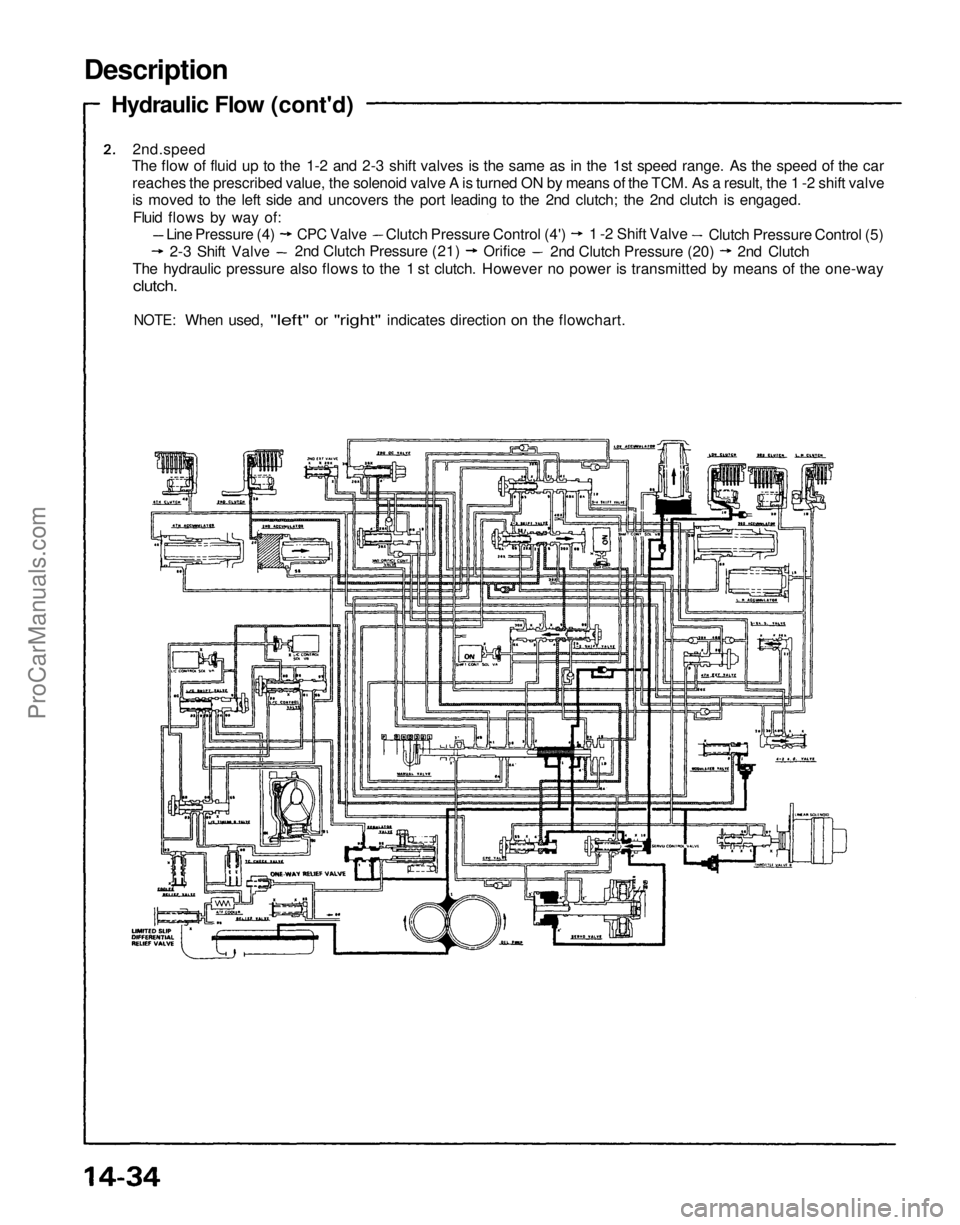
Description
Hydraulic Flow (cont'd)
2nd.speed
The flow of fluid up to the 1-2 and 2-3 shift valves is the same as in the 1st speed range. As the speed of the car
reaches the prescribed value, the solenoid valve A is turned ON by means of the TCM. As a result, the 1 -2 shift valve
is moved to the left side and uncovers the port leading to the 2nd clutch; the 2nd clutch is engaged.
Fluid flows by way of:
Line Pressure (4)
2-3 Shift Valve
CPC Valve
Clutch Pressure Control (4')
1 -2 Shift Valve
Clutch Pressure Control (5)
2nd Clutch Pressure (21)
Orifice
2nd Clutch Pressure (20)
2nd Clutch
The hydraulic pressure also flows to the 1 st clutch. However no power is transmitted by means of the one-way
clutch.
NOTE:
When used,
"left"
or
"right"
indicates direction
on the
flowchart.ProCarManuals.com
Page 1196 of 1640
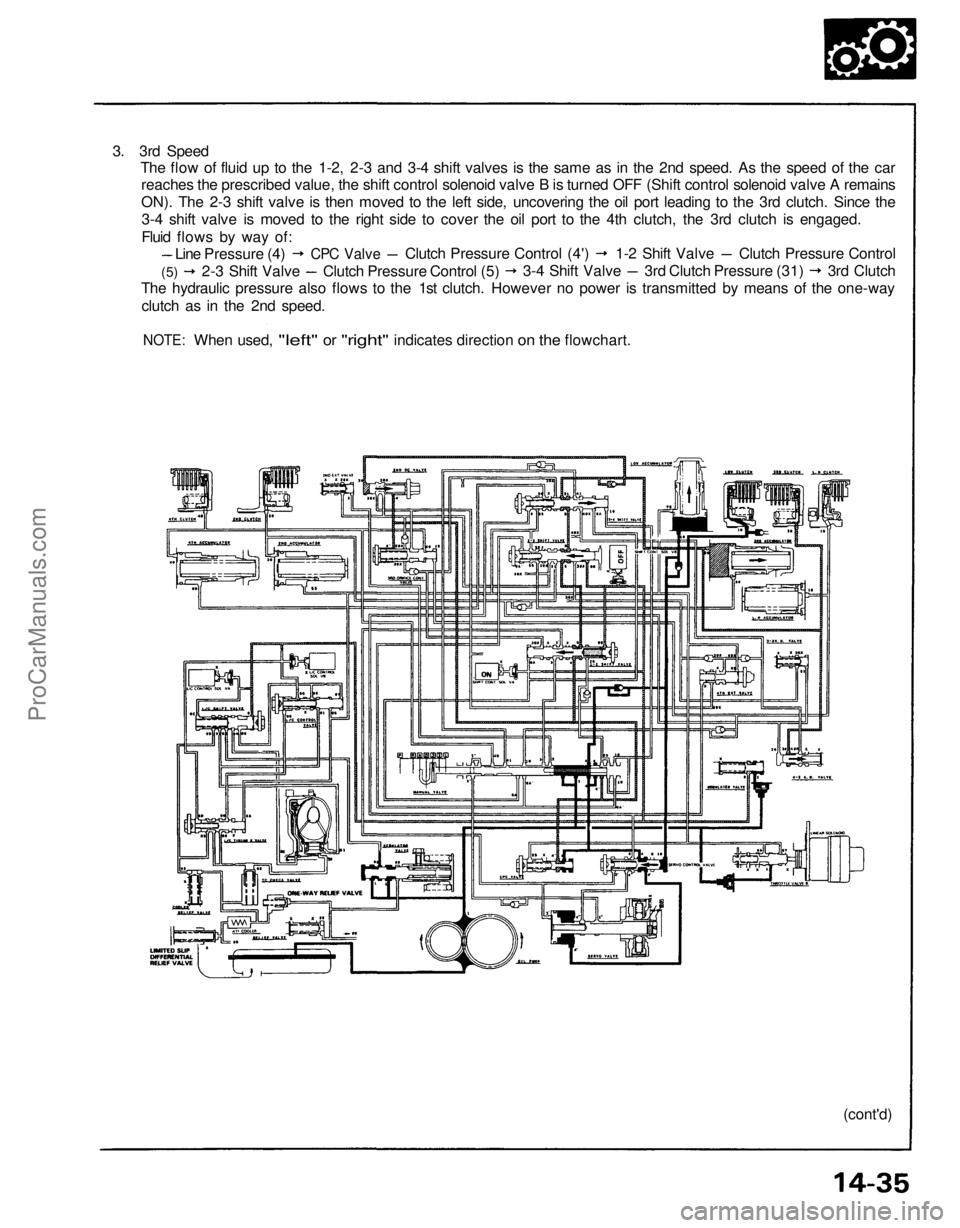
3. 3rd Speed
The flow of fluid up to the 1-2, 2-3 and 3-4 shift valves is the same as in the 2nd speed. As the speed of the car
reaches the prescribed value, the shift control solenoid valve B is turned OFF (Shift control solenoid valve A remains
ON). The 2-3 shift valve is then moved to the left side, uncovering the oil port leading to the 3rd clutch. Since the
3-4 shift valve is moved to the right side to cover the oil port to the 4th clutch, the 3rd clutch is engaged.
Fluid flows by way of:
(cont'd)
Line Pressure (4)
CPC Valve
Clutch Pressure Control (4')
1-2 Shift Valve
Clutch Pressure Control
(5)
2-3 Shift Valve
Clutch Pressure Control (5)
3-4 Shift Valve
3rd Clutch Pressure (31)
3rd Clutch
The hydraulic pressure also flows to the 1st clutch. However no power is transmitted by means of the one-way
clutch as in the 2nd speed.
NOTE:
When used,
"left"
or
"right"
indicates direction
on the
flowchart.ProCarManuals.com
Page 1197 of 1640
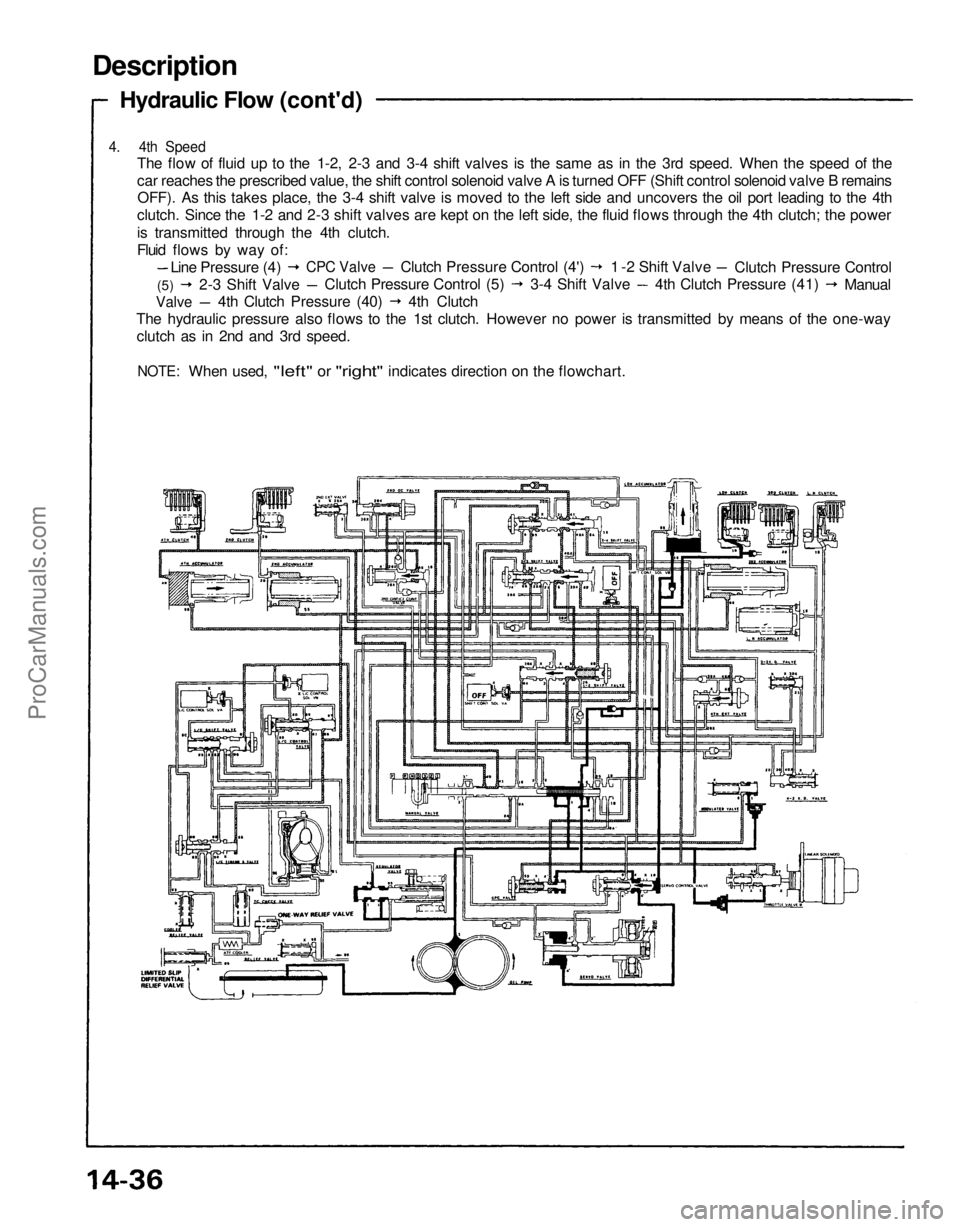
Description
Hydraulic Flow (cont'd)
4. 4th Speed
The flow of fluid up to the 1-2, 2-3 and 3-4 shift valves is the same as in the 3rd speed. When the speed of the
car reaches the prescribed value, the shift control solenoid valve A is turned OFF (Shift control solenoid valve B remains
OFF). As this takes place, the 3-4 shift valve is moved to the left side and uncovers the oil port leading to the 4th
clutch. Since the 1-2 and 2-3 shift valves are kept on the left side, the fluid flows through the 4th clutch; the power
is transmitted through the 4th clutch.
Fluid flows by way of:
Line Pressure (4)
CPC Valve
Clutch Pressure Control (4')
1 -2 Shift Valve
Clutch Pressure Control
(5)
2-3 Shift Valve
Clutch Pressure Control (5)
3-4 Shift Valve
4th Clutch Pressure (41)
Manual
Valve
4th Clutch Pressure (40)
4th Clutch
The hydraulic pressure also flows to the 1st clutch. However no power is transmitted by means of the one-way
clutch as in 2nd and 3rd speed.
NOTE:
When used,
"left"
or
"right"
indicates direction
on the
flowchart.ProCarManuals.com
Page 1198 of 1640
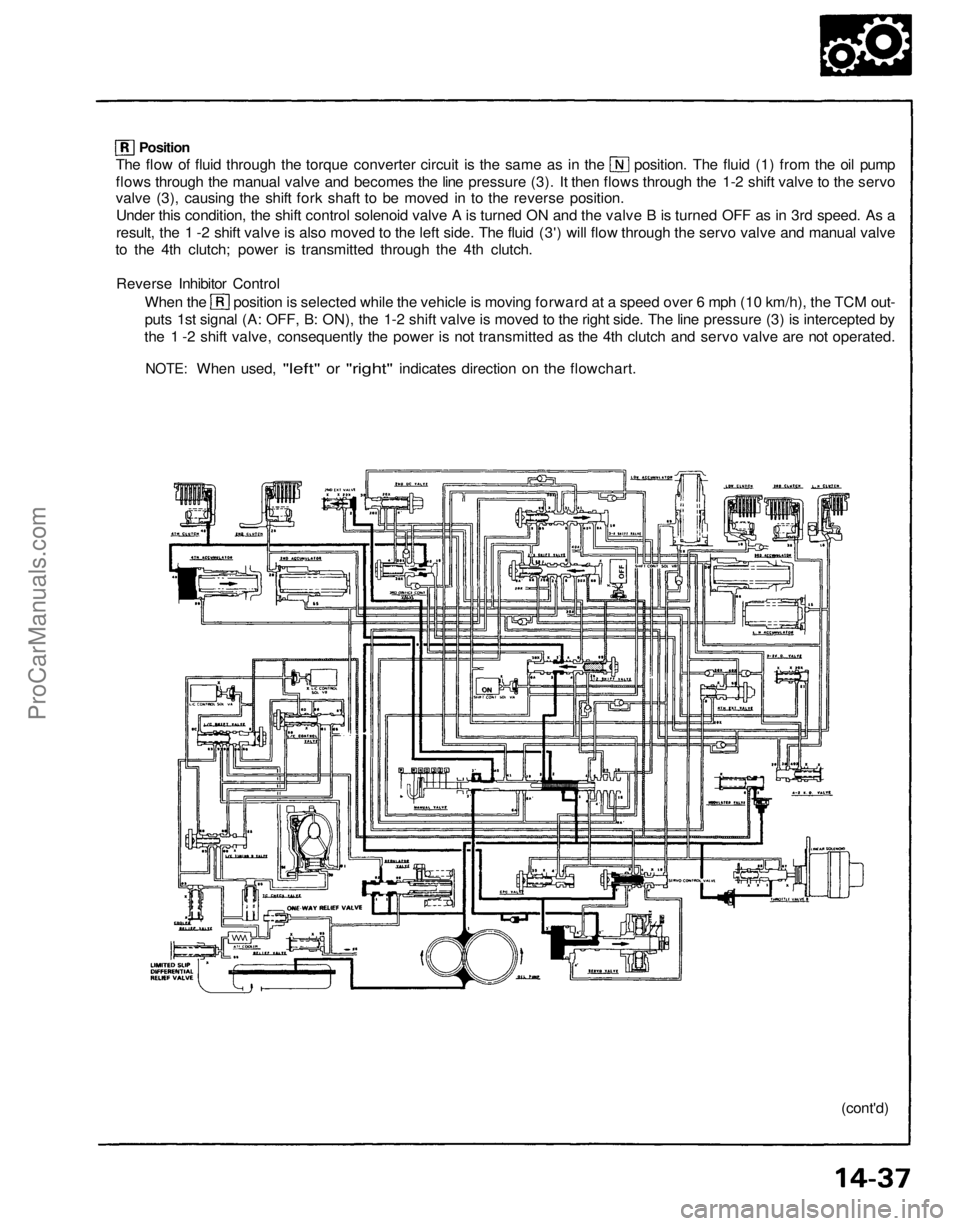
The flow of fluid through the torque converter circuit is the same as in the position. The fluid (1) from the oil pump
flows through the manual valve and becomes the line pressure (3). It then flows through the 1-2 shift valve to the servo
valve (3), causing the shift fork shaft to be moved in to the reverse position.
Under this condition, the shift control solenoid valve A is turned ON and the valve B is turned OFF as in 3rd speed. As a
result, the 1 -2 shift valve is also moved to the left side. The fluid (3') will flow through the servo valve and manual valve
to the 4th clutch; power is transmitted through the 4th clutch.
Reverse Inhibitor Control
When the position is selected while the vehicle is moving forward at a speed over 6 mph (10 km/h), the TCM out-
puts 1st signal (A: OFF, B: ON), the 1-2 shift valve is moved to the right side. The line pressure (3) is intercepted by
the 1 -2 shift valve, consequently the power is not transmitted as the 4th clutch and servo valve are not operated.
NOTE:
When used,
"left"
or
"right"
indicates direction
on the
flowchart.
(cont'd)
PositionProCarManuals.com
Page 1199 of 1640
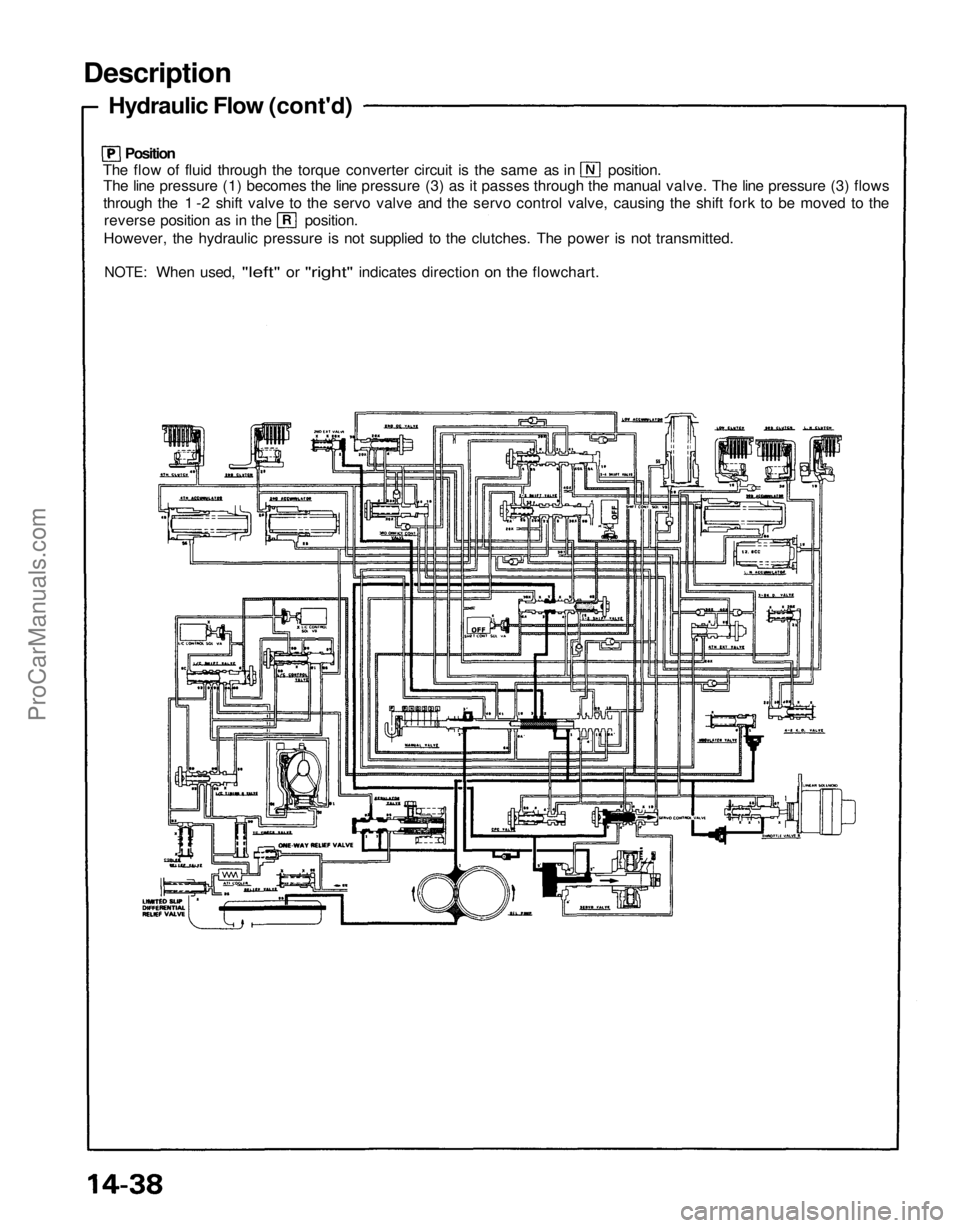
Description
Hydraulic Flow (cont'd)
Position
The flow of fluid through the torque converter circuit is the same as in position.
The line pressure (1) becomes the line pressure (3) as it passes through the manual valve. The line pressure (3) flows
through the 1 -2 shift valve to the servo valve and the servo control valve, causing the shift fork to be moved to the
reverse position as in the position.
However, the hydraulic pressure is not supplied to the clutches. The power is not transmitted.
NOTE:
When used,
"left"
or
"right"
indicates direction
on the
flowchart.ProCarManuals.com
Page 1200 of 1640
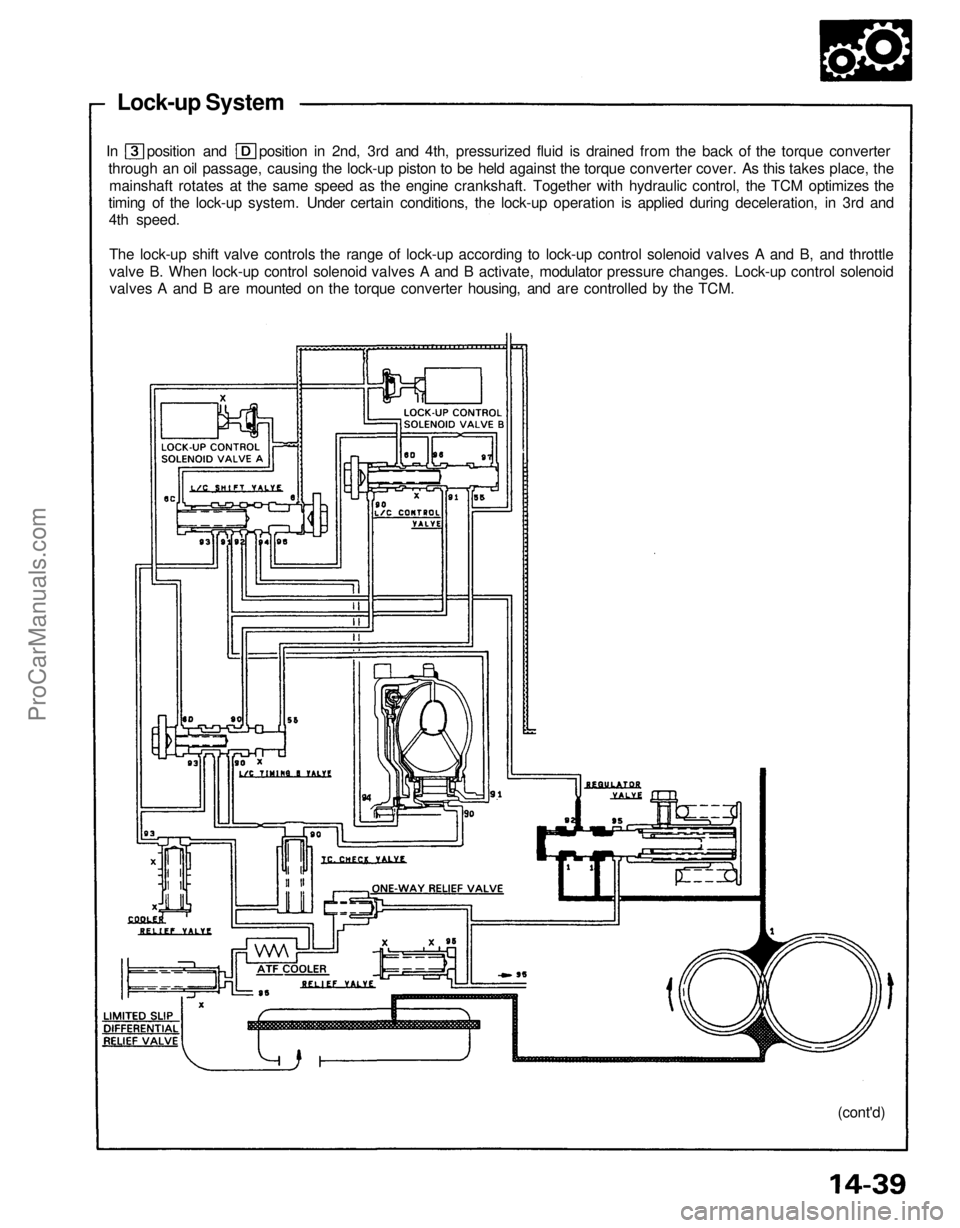
Lock-up System
In position and position in 2nd, 3rd and 4th, pressurized fluid is drained from the back of the torque converter
through an oil passage, causing the lock-up piston to be held against the torque converter cover. As this takes place, themainshaft rotates at the same speed as the engine crankshaft. Together with hydraulic control, the TCM optimizes the
timing of the lock-up system. Under certain conditions, the lock-up operation is applied during deceleration, in 3rd and 4th speed.
The lock-up shift valve controls the range of lock-up according to lock-up control solenoid valves A and B, and throttle
valve B. When lock-up control solenoid valves A and B activate, modulator pressure changes. Lock-up control solenoidvalves A and B are mounted on the torque converter housing, and are controlled by the TCM.
(cont'd)ProCarManuals.com